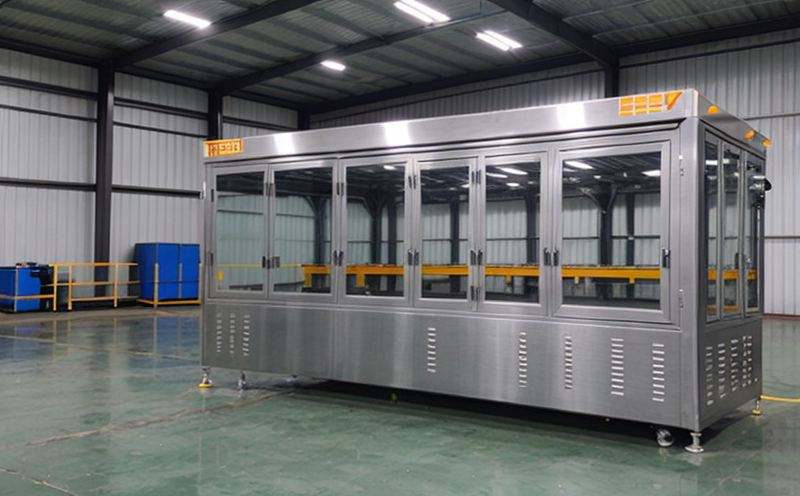ISO 9017 Impact Testing of Metal Sheets
The ISO 9017 impact testing method is a critical procedure in the quality assurance process of metal packaging materials. This test evaluates the resistance of metal sheets to dynamic impacts, which is essential for ensuring that these materials can withstand real-world conditions during transportation and use. The standard is widely used across various industries, including food, pharmaceuticals, and consumer goods, where robust packaging plays a pivotal role in protecting products.
The testing process involves subjecting metal sheets to controlled impact forces using specialized equipment designed to mimic the stressors encountered in transit or handling. This method helps manufacturers identify potential weaknesses in their product design and materials selection early on in the development cycle. By adhering to strict ISO guidelines, companies can ensure they meet international standards for safety and reliability.
Impact testing is particularly important when dealing with thin-gauge metals like aluminum or tinplate used in food cans or aerosol containers. These materials must be tough enough to maintain structural integrity under varying conditions while remaining lightweight and cost-effective. A failure during impact testing could lead to leaks, dents, or even complete structural collapse of the packaging, resulting in product contamination and loss.
The procedure typically begins with preparing the metal samples according to specified dimensions outlined in ISO 9017. Specimens are then mounted onto a rigid support system within a controlled environment that simulates typical storage or shipping conditions. Next comes the impact application phase where high-speed impacts are delivered via specialized equipment calibrated to specific energy levels.
Results from these tests provide valuable insights into how well different types of metals respond to sudden mechanical shocks. Engineers can use this information not only for improving current designs but also for exploring new alloy compositions that offer enhanced performance characteristics. For instance, certain combinations of alloys may exhibit superior strength-to-weight ratios compared to single-metal options.
Understanding the results obtained through ISO 9017 testing allows quality managers and compliance officers to make informed decisions about raw material sourcing and manufacturing processes. R&D engineers benefit from this data as it guides their efforts towards developing innovative solutions that enhance product durability without sacrificing affordability or environmental sustainability goals.
In summary, ISO 9017 impact testing serves multiple purposes beyond just meeting regulatory requirements; it supports continuous improvement initiatives aimed at enhancing overall packaging quality across diverse sectors. Its role in maintaining high standards of safety and efficacy cannot be overstated, making it an indispensable tool for any organization involved with metal packaging production.
Scope and Methodology
| Equipment | Description |
|---|---|
| Impact Tester | A device capable of delivering controlled impact forces to the metal specimens. |
| Sensor Unit | To measure and record the force applied during each test cycle. |
| Mounting System | Ensures proper alignment and positioning of the samples relative to the impact point. |
| Step | Description |
|---|---|
| Material Selection | Choose metal sheets representative of the intended application. |
| Cutting Dimensions | Trim samples to standard sizes as per ISO 9017 specifications. |
| Surface Finish | Avoid rough surfaces that could affect test accuracy; polish if necessary. |
The testing process follows a structured protocol aimed at replicating real-world scenarios while maintaining precision. Each step is crucial for obtaining accurate results that reflect the true capabilities of the metal packaging under evaluation. Compliance with ISO 9017 ensures consistency and reliability across multiple trials, enabling manufacturers to draw valid conclusions regarding material performance.
Customer Impact and Satisfaction
- Enhanced Product Reliability: Clients benefit from reduced risk of product damage during transport or handling. This leads to increased customer satisfaction as they receive undamaged goods.
- Informed Decision-Making: By identifying potential issues early in the design phase, clients can optimize their packaging solutions for better performance and cost-effectiveness.
- Improved Reputation: Demonstrating adherence to international standards enhances a company’s reputation among stakeholders. This builds trust with customers and fosters long-term relationships.
- Cost Savings: Early detection of flaws through rigorous testing prevents costly rework or scrap during production runs.
A satisfied client base translates into higher sales volumes, which ultimately drives profitability for the organization. Moreover, having a robust metal packaging solution that meets stringent quality benchmarks positions businesses favorably against competitors in competitive markets.
International Acceptance and Recognition
- Global Standard: ISO 9017 has been adopted by numerous countries around the world as a benchmark for impact testing metal sheets. Its widespread acceptance ensures compatibility between suppliers and customers operating in different geographical regions.
- Regulatory Compliance: Many regulatory bodies require adherence to international standards like ISO when certifying products or approving new materials.
- Ease of Communication: Using a universally recognized standard facilitates smoother communication among industry professionals, reducing misunderstandings and improving collaboration.
The rigorous nature of the ISO 9017 specification contributes significantly to its credibility. It has been validated through extensive research and peer review processes conducted by experts in materials science and engineering. As such, it enjoys broad support from academia, government agencies, and private sector entities alike.





